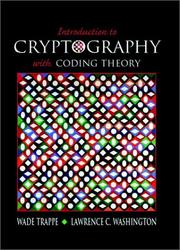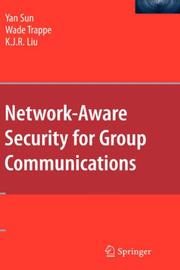| Listing 1 - 10 of 13 | << page >> |
Sort by
|
Book
ISBN: 1441914102 144191384X 9786612837890 1441913858 1282837893 1489983759 Year: 2010 Publisher: New York ; London : Springer,
Abstract | Keywords | Export | Availability | Bookmark
 Loading...
Loading...Choose an application
- Reference Manager
- EndNote
- RefWorks (Direct export to RefWorks)
Wireless systems are becoming increasingly pervasive and securing these systems has been challenging, in large part due to the unique properties associated with wireless communications. Securing these networks has traditionally been approached by taking a conventional approach involving cryptographic protocols. Such an approach inherently seeks to secure the wireless network at the link layer and above, and consequently fails to leverage the most unique characteristic of wireless communication: its physical layer. Securing Wireless Communications at the Physical Layer is a compilation of contributions by experts in wireless communications and security, and presents state-of-the-art results that examine the challenge of introducing security at the physical layer of a wireless system. Throughout this book there is an underlying theme that the rich multipath environment that is typical of wireless scenarios supports the establishment of new security services at the physical layer, including new mechanisms that establish cryptographic keys, that support communication with assured confidentiality, and that can authenticate transmitters in mobile environments. The book takes a holistic approach to covering topics related to physical layer security solutions, with contributions ranging from the theoretical underpinnings behind secure communications to practical systems validations that have been performed on real wireless systems. The book also covers topics related to ensuring that cooperative wireless communications at the physical layer is trustworthy. Additionally, the emerging area of modulation forensics, whereby a device is able to identify the modulation format being employed by other devices is explored. Securing Wireless Communications at the Physical Layer will serve as a valuable reference to engineers and researchers in the fields of security and wireless communications.
Wireless communication systems --- Electrical & Computer Engineering --- Telecommunications --- Electrical Engineering --- Engineering & Applied Sciences --- Security measures --- Telecommunication --- Security measures. --- Engineering. --- Data structures (Computer science). --- Data encryption (Computer science). --- Electrical engineering. --- Communications Engineering, Networks. --- Signal, Image and Speech Processing. --- Data Structures, Cryptology and Information Theory. --- Data Encryption. --- Telecommunication. --- Data structures (Computer scienc. --- Data Structures and Information Theory. --- Cryptology. --- Data encoding (Computer science) --- Encryption of data (Computer science) --- Computer security --- Cryptography --- Electric communication --- Mass communication --- Telecom --- Telecommunication industry --- Communication --- Information theory --- Telecommuting --- Signal processing. --- Image processing. --- Speech processing systems. --- Information structures (Computer science) --- Structures, Data (Computer science) --- Structures, Information (Computer science) --- Electronic data processing --- File organization (Computer science) --- Abstract data types (Computer science) --- Computational linguistics --- Electronic systems --- Modulation theory --- Oral communication --- Speech --- Singing voice synthesizers --- Pictorial data processing --- Picture processing --- Processing, Image --- Imaging systems --- Optical data processing --- Processing, Signal --- Information measurement --- Signal theory (Telecommunication) --- Electric engineering --- Engineering
Digital
ISBN: 9781441913852 9781441914101 9781489983756 9781441913845 Year: 2010 Publisher: New York, NY Springer US
Abstract | Keywords | Export | Availability | Bookmark
 Loading...
Loading...Choose an application
- Reference Manager
- EndNote
- RefWorks (Direct export to RefWorks)
Wireless systems are becoming increasingly pervasive and securing these systems has been challenging, in large part due to the unique properties associated with wireless communications. Securing these networks has traditionally been approached by taking a conventional approach involving cryptographic protocols. Such an approach inherently seeks to secure the wireless network at the link layer and above, and consequently fails to leverage the most unique characteristic of wireless communication: its physical layer. Securing Wireless Communications at the Physical Layer is a compilation of contributions by experts in wireless communications and security, and presents state-of-the-art results that examine the challenge of introducing security at the physical layer of a wireless system. Throughout this book there is an underlying theme that the rich multipath environment that is typical of wireless scenarios supports the establishment of new security services at the physical layer, including new mechanisms that establish cryptographic keys, that support communication with assured confidentiality, and that can authenticate transmitters in mobile environments. The book takes a holistic approach to covering topics related to physical layer security solutions, with contributions ranging from the theoretical underpinnings behind secure communications to practical systems validations that have been performed on real wireless systems. The book also covers topics related to ensuring that cooperative wireless communications at the physical layer is trustworthy. Additionally, the emerging area of modulation forensics, whereby a device is able to identify the modulation format being employed by other devices is explored. Securing Wireless Communications at the Physical Layer will serve as a valuable reference to engineers and researchers in the fields of security and wireless communications.
Electrical engineering --- Applied physical engineering --- Mass communications --- Programming --- Information systems --- Computer. Automation --- DIP (documentimage processing) --- beeldverwerking --- cryptografie --- spraaktechnologie --- informatica --- informatietechnologie --- elektrotechniek --- communicatietechnologie --- signaalverwerking
Book
ISBN: 0131981994 Year: 2006 Publisher: London Pearson/Prentice Hall
Abstract | Keywords | Export | Availability | Bookmark
 Loading...
Loading...Choose an application
- Reference Manager
- EndNote
- RefWorks (Direct export to RefWorks)
Computer science --- Computer architecture. Operating systems --- Coding theory. --- Cryptography.

ISBN: 0130618144 Year: 2001 Publisher: Upper Saddle River Prentice Hall
Abstract | Keywords | Export | Availability | Bookmark
 Loading...
Loading...Choose an application
- Reference Manager
- EndNote
- RefWorks (Direct export to RefWorks)
Samenvatting:For advanced undergraduate courses in cryptography and network securityin departments of math and computer science.Assumes a minimal background in programming and a level of mathsophistication equivalent to a course in linear algebra.
Beveiliging. --- Cryptografie. --- Coding theory --- Cryptography --- 519.72 --- 519.72 Information theory: mathematical aspects --- Information theory: mathematical aspects --- Cryptanalysis --- Cryptology --- Secret writing --- Steganography --- Signs and symbols --- Symbolism --- Writing --- Ciphers --- Data encryption (Computer science) --- Data compression (Telecommunication) --- Digital electronics --- Information theory --- Machine theory --- Signal theory (Telecommunication) --- Computer programming

ISBN: 0131862391 Year: 2006 Publisher: Upper Saddle River, N.J. : Pearson Prentice Hall,
Abstract | Keywords | Export | Availability | Bookmark
 Loading...
Loading...Choose an application
- Reference Manager
- EndNote
- RefWorks (Direct export to RefWorks)
Book
ISBN: 9781441913852 9781441914101 9781489983756 9781441913845 Year: 2010 Publisher: Boston, MA Springer US
Abstract | Keywords | Export | Availability | Bookmark
 Loading...
Loading...Choose an application
- Reference Manager
- EndNote
- RefWorks (Direct export to RefWorks)
Wireless systems are becoming increasingly pervasive and securing these systems has been challenging, in large part due to the unique properties associated with wireless communications. Securing these networks has traditionally been approached by taking a conventional approach involving cryptographic protocols. Such an approach inherently seeks to secure the wireless network at the link layer and above, and consequently fails to leverage the most unique characteristic of wireless communication: its physical layer. Securing Wireless Communications at the Physical Layer is a compilation of contributions by experts in wireless communications and security, and presents state-of-the-art results that examine the challenge of introducing security at the physical layer of a wireless system. Throughout this book there is an underlying theme that the rich multipath environment that is typical of wireless scenarios supports the establishment of new security services at the physical layer, including new mechanisms that establish cryptographic keys, that support communication with assured confidentiality, and that can authenticate transmitters in mobile environments. The book takes a holistic approach to covering topics related to physical layer security solutions, with contributions ranging from the theoretical underpinnings behind secure communications to practical systems validations that have been performed on real wireless systems. The book also covers topics related to ensuring that cooperative wireless communications at the physical layer is trustworthy. Additionally, the emerging area of modulation forensics, whereby a device is able to identify the modulation format being employed by other devices is explored. Securing Wireless Communications at the Physical Layer will serve as a valuable reference to engineers and researchers in the fields of security and wireless communications.
Electrical engineering --- Applied physical engineering --- Mass communications --- Programming --- Information systems --- Computer. Automation --- DIP (documentimage processing) --- beeldverwerking --- cryptografie --- spraaktechnologie --- informatica --- informatietechnologie --- elektrotechniek --- communicatietechnologie --- signaalverwerking

ISBN: 1281087505 9786611087500 038768848X 0387688463 1441943358 Year: 2008 Publisher: New York : Springer,
Abstract | Keywords | Export | Availability | Bookmark
 Loading...
Loading...Choose an application
- Reference Manager
- EndNote
- RefWorks (Direct export to RefWorks)
Network-Aware Security for Group Communications fills a growing need in the research community for a reference that describes the state-of-the-art in securing group communications in emerging networks and for future applications. The growth of multi-user services makes it essential that a complementary suite of security solutions are deployed in order to protect these services from a broad spectrum of security threats that are unique to group communications. This book is focused on tailoring security solutions to the underlying network architecture (such as the wireless cellular network, or ad hoc and sensor networks), or to targeted applications using methods tailored for that application (such as multimedia multicasts). The authors focus the discussion on two fundamental security issues for group communications: providing efficient key management for providing confidentiality, and providing authentication for group services.
Computer networks --- Telecommunication --- Teleconferencing. --- Security measures. --- Computer network security --- Network security, Computer --- Security of computer networks --- Computer security --- Telecommunication. --- Data structures (Computer scienc. --- Data encryption (Computer science). --- Computer Communication Networks. --- Computer network architectures. --- Communications Engineering, Networks. --- Signal, Image and Speech Processing. --- Data Structures and Information Theory. --- Cryptology. --- Computer Systems Organization and Communication Networks. --- Data structures (Computer science) --- Data encoding (Computer science) --- Encryption of data (Computer science) --- Cryptography --- Electric communication --- Mass communication --- Telecom --- Telecommunication industry --- Telecommunications --- Communication --- Information theory --- Telecommuting --- Architectures, Computer network --- Network architectures, Computer --- Computer architecture --- Electrical engineering. --- Signal processing. --- Image processing. --- Speech processing systems. --- Data structures (Computer science). --- Computer communication systems. --- Computer organization. --- Organization, Computer --- Electronic digital computers --- Communication systems, Computer --- Computer communication systems --- Data networks, Computer --- ECNs (Electronic communication networks) --- Electronic communication networks --- Networks, Computer --- Teleprocessing networks --- Data transmission systems --- Digital communications --- Electronic systems --- Information networks --- Cyberinfrastructure --- Electronic data processing --- Network computers --- Information structures (Computer science) --- Structures, Data (Computer science) --- Structures, Information (Computer science) --- File organization (Computer science) --- Abstract data types (Computer science) --- Computational linguistics --- Modulation theory --- Oral communication --- Speech --- Singing voice synthesizers --- Pictorial data processing --- Picture processing --- Processing, Image --- Imaging systems --- Optical data processing --- Processing, Signal --- Information measurement --- Signal theory (Telecommunication) --- Electric engineering --- Engineering --- Distributed processing
Book
ISBN: 3319073567 3319073559 1322136521 Year: 2014 Publisher: Cham : Springer International Publishing : Imprint: Springer,
Abstract | Keywords | Export | Availability | Bookmark
 Loading...
Loading...Choose an application
- Reference Manager
- EndNote
- RefWorks (Direct export to RefWorks)
This Springer Brief provides a new approach to prevent user spoofing by using the physical properties associated with wireless transmissions to detect the presence of user spoofing. The most common method, applying cryptographic authentication, requires additional management and computational power that cannot be deployed consistently. The authors present the new approach by offering a summary of the recent research and exploring the benefits and potential challenges of this method. This brief discusses the feasibility of launching user spoofing attacks and their impact on the wireless and sensor networks. Readers are equipped to understand several system models. One attack detection model exploits the spatial correlation of received signal strength (RSS) inherited from wireless devices as a foundation. Through experiments in practical environments, the authors evaluate the performance of the spoofing attack detection model. The brief also introduces the DEMOTE system, which exploits the correlation within the RSS trace based on each device’s identity to detect mobile attackers. A final chapter covers future directions of this field. By presenting complex technical information in a concise format, this brief is a valuable resource for researchers, professionals, and advanced-level students focused on wireless network security.
Wireless communication systems --- Internet --- Security measures. --- Computer security. --- Computer Communication Networks. --- Information systems. --- Systems and Data Security. --- Information Systems and Communication Service. --- Information Systems Applications (incl. Internet). --- Computer privacy --- Computer system security --- Computer systems --- Computers --- Cyber security --- Cybersecurity --- Electronic digital computers --- Protection of computer systems --- Security of computer systems --- Data protection --- Security systems --- Hacking --- Protection --- Security measures --- Computer communication systems. --- Computers. --- Application software. --- Application computer programs --- Application computer software --- Applications software --- Apps (Computer software) --- Computer software --- Automatic computers --- Automatic data processors --- Computer hardware --- Computing machines (Computers) --- Electronic brains --- Electronic calculating-machines --- Electronic computers --- Hardware, Computer --- Cybernetics --- Machine theory --- Calculators --- Cyberspace --- Communication systems, Computer --- Computer communication systems --- Data networks, Computer --- ECNs (Electronic communication networks) --- Electronic communication networks --- Networks, Computer --- Teleprocessing networks --- Data transmission systems --- Digital communications --- Electronic systems --- Information networks --- Telecommunication --- Cyberinfrastructure --- Electronic data processing --- Network computers --- Distributed processing
Digital
ISBN: 9780387688480 Year: 2008 Publisher: Boston, MA Springer Science+Business Media, LLC
Abstract | Keywords | Export | Availability | Bookmark
 Loading...
Loading...Choose an application
- Reference Manager
- EndNote
- RefWorks (Direct export to RefWorks)
Mass communications --- Computer science --- Computer architecture. Operating systems --- Information systems --- Computer. Automation --- beeldverwerking --- DES (data encryption standard) --- cryptologie --- computerbesturingssystemen --- programmatielogica --- OS (operating system) --- computernetwerken --- communicatietechnologie --- signaalverwerking
Digital
ISBN: 9783319073569 Year: 2014 Publisher: Cham Springer International Publishing
Abstract | Keywords | Export | Availability | Bookmark
 Loading...
Loading...Choose an application
- Reference Manager
- EndNote
- RefWorks (Direct export to RefWorks)
This Springer Brief provides a new approach to prevent user spoofing by using the physical properties associated with wireless transmissions to detect the presence of user spoofing. The most common method, applying cryptographic authentication, requires additional management and computational power that cannot be deployed consistently. The authors present the new approach by offering a summary of the recent research and exploring the benefits and potential challenges of this method. This brief discusses the feasibility of launching user spoofing attacks and their impact on the wireless and sensor networks. Readers are equipped to understand several system models. One attack detection model exploits the spatial correlation of received signal strength (RSS) inherited from wireless devices as a foundation. Through experiments in practical environments, the authors evaluate the performance of the spoofing attack detection model. The brief also introduces the DEMOTE system, which exploits the correlation within the RSS trace based on each device’s identity to detect mobile attackers. A final chapter covers future directions of this field. By presenting complex technical information in a concise format, this brief is a valuable resource for researchers, professionals, and advanced-level students focused on wireless network security.
Computer science --- Computer architecture. Operating systems --- Information systems --- Computer. Automation --- ICT (informatie- en communicatietechnieken) --- draadloze computernetwerken --- mobiele netwerken --- computers --- informatica --- informatiesystemen --- computerbeveiliging --- computernetwerken --- computerkunde
| Listing 1 - 10 of 13 | << page >> |
Sort by
|

 Search
Search Feedback
Feedback About UniCat
About UniCat  Help
Help News
News